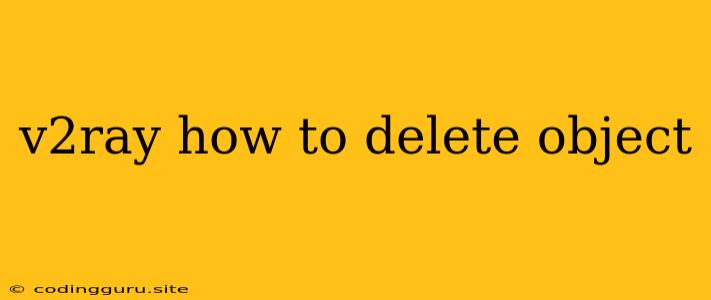How to Delete Objects in v2Ray
V2Ray is a powerful and versatile tool for bypassing network restrictions and enhancing privacy. While setting up and configuring v2Ray can be straightforward, managing your configuration files and understanding how to delete objects within the system might require some extra attention. This guide aims to provide a comprehensive understanding of how to delete objects within v2Ray, focusing on both core configuration files and specific settings.
What are Objects in v2Ray?
In the context of v2Ray, "objects" refer to various elements that make up your configuration. These elements can range from simple settings like inbound or outbound configurations to more complex components like proxies or routing rules. To effectively manage your v2Ray setup, understanding how to modify or delete these objects is crucial.
Why Delete Objects in v2Ray?
There are various reasons why you might need to delete objects within v2Ray:
- Cleaning Up Unused Configurations: Over time, your v2Ray configuration might accumulate settings that are no longer needed. Deleting these objects simplifies your setup and can improve performance.
- Troubleshooting Issues: If you are encountering issues with v2Ray, removing and re-adding specific objects can help pinpoint the root cause of the problem.
- Experimenting with Different Settings: When experimenting with different v2Ray configurations, deleting objects allows you to start with a clean slate.
How to Delete Objects in v2Ray
The process of deleting objects in v2Ray is largely dependent on the specific object you want to remove and your operating system. Here's a general approach:
-
Identify the Object:
- Configuration Files: Open your v2Ray configuration file (
config.json). The configuration file contains the definitions of all the objects you have set up. - GUI Tools: If you are using a graphical interface for managing v2Ray, the tools typically provide visual representations of your objects.
- Configuration Files: Open your v2Ray configuration file (
-
Locate the Object's Definition: Within the configuration file, you need to locate the section that defines the object you want to delete. For example, to delete an inbound object named
inbound_tcp, you would search for the section that starts with:{ "tag": "inbound_tcp", "port": 1080, // ... other settings } -
Delete the Object's Definition: Remove the entire section of the configuration file that pertains to the object you want to delete. In the example above, you would remove the entire object definition enclosed within curly braces
{}. -
Save the Configuration File: Save the changes you have made to your configuration file.
-
Restart v2Ray: After making changes to the configuration file, it's crucial to restart your v2Ray service for the modifications to take effect.
Examples of Deleting Objects:
Deleting an Inbound Object:
{
"log": {
"access": "/var/log/v2ray/access.log",
"error": "/var/log/v2ray/error.log",
"loglevel": "warning"
},
"inbound": [
{
"tag": "inbound_tcp",
"port": 1080,
"protocol": "tcp",
"sniffing": {
"enabled": true,
"destOverride": [
"http",
"tls"
]
},
"settings": {
"tcpSettings": {
"timeout": 10000
}
}
}
],
// ... other objects
}
To delete the inbound_tcp object, remove the entire object definition:
{
"log": {
"access": "/var/log/v2ray/access.log",
"error": "/var/log/v2ray/error.log",
"loglevel": "warning"
},
"inbound": [
],
// ... other objects
}
Deleting an Outbound Object:
{
"log": {
"access": "/var/log/v2ray/access.log",
"error": "/var/log/v2ray/error.log",
"loglevel": "warning"
},
"outbound": {
"protocol": "freedom",
"settings": {},
"tag": "outbound_freedom"
},
"inbound": [
// ... inbound objects
],
// ... other objects
}
To delete the outbound_freedom object, remove the entire object definition:
{
"log": {
"access": "/var/log/v2ray/access.log",
"error": "/var/log/v2ray/error.log",
"loglevel": "warning"
},
"outbound": {},
"inbound": [
// ... inbound objects
],
// ... other objects
}
Tips for Deleting Objects:
- Backup Your Configuration File: Always create a backup of your
config.jsonfile before making any changes. This will allow you to restore the configuration if you accidentally delete an object you need. - Use a Text Editor: For manipulating the configuration file, use a plain text editor like Notepad (Windows) or TextEdit (Mac).
- Test After Deleting: After deleting an object, restart v2Ray and test your network connection to ensure the changes didn't cause any issues.
Conclusion
Deleting objects in v2Ray is a simple but essential skill for effectively managing your configuration. By understanding the process and following the tips outlined in this guide, you can easily remove unnecessary objects, troubleshoot issues, and experiment with different settings to optimize your v2Ray setup for privacy and security.
